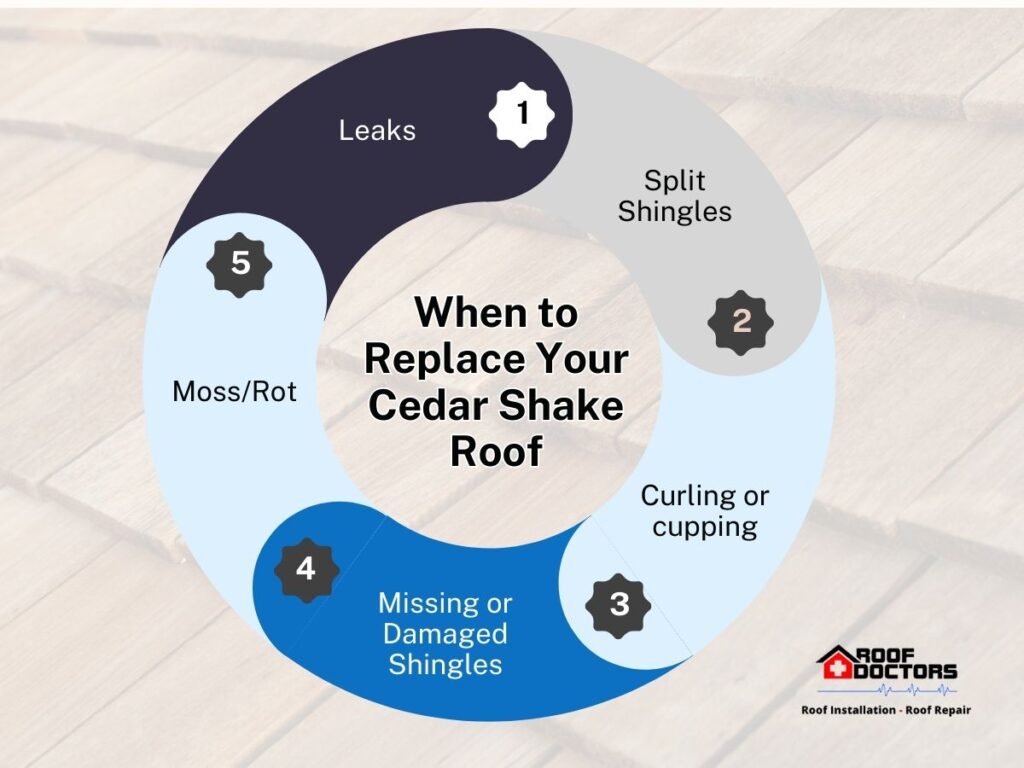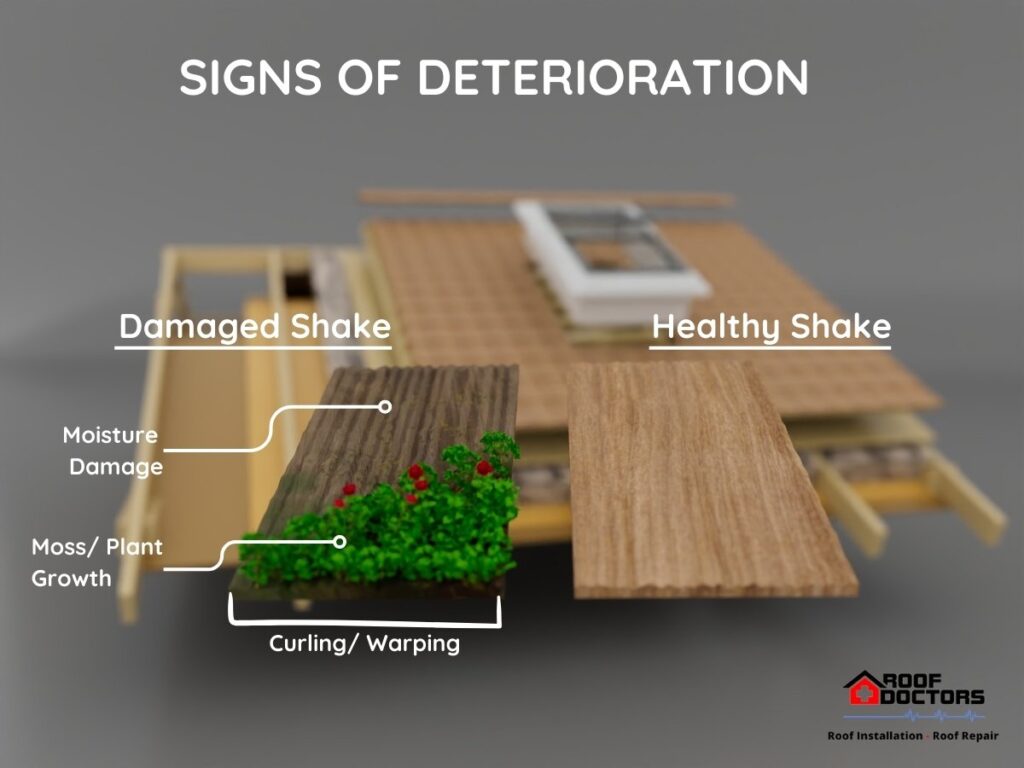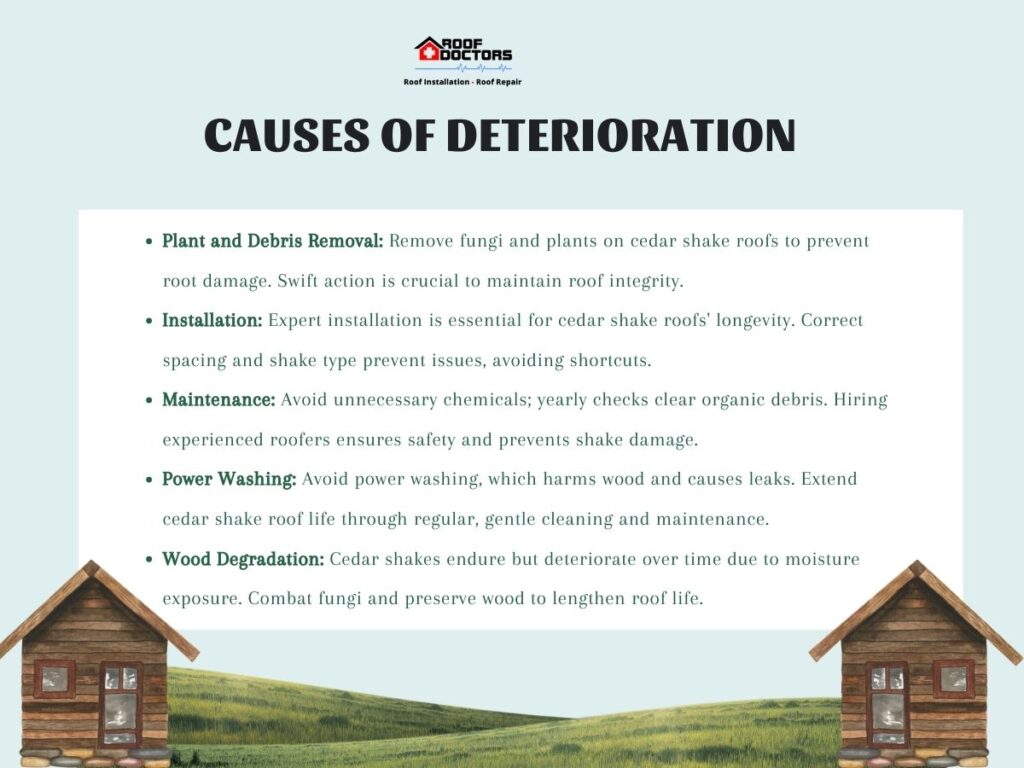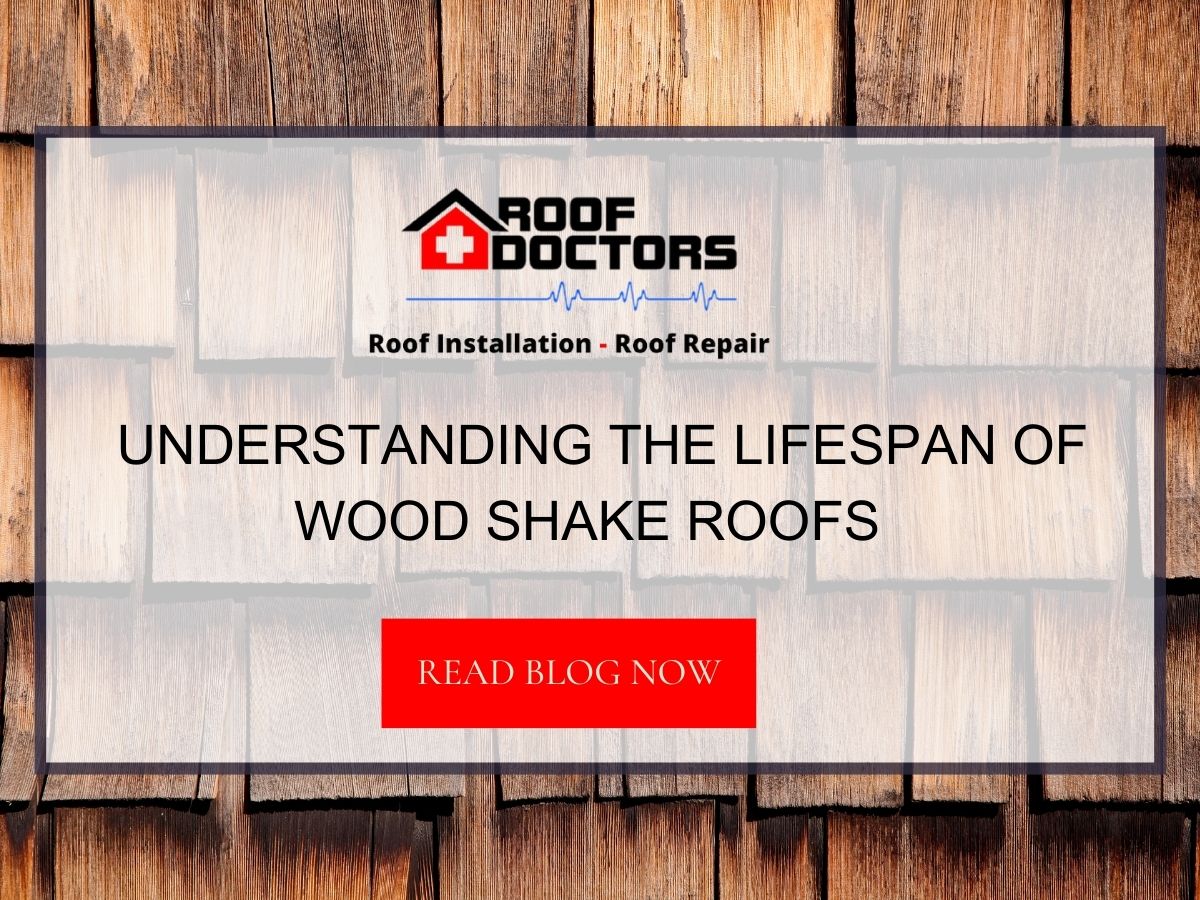A building’s durability and sustainability are directly tied to the quality of its roofing materials. Historically, cedar roof shakes have been one of the most preferred options because of the aesthetic value they bring to a home.
Understanding the lifespan of wood shake roofs and how well they can be maintained is a complex topic that depends on a number of factors. In modern construction, this article seeks to identify the variables that affect the lifespan of wood shakes.
What Are Wood Shake Roofs?

Wood shake has long been the chosen species for roofing since it is resistant to insect infestations and holds up well under all types of weather conditions, provided it is maintained properly. Wooden shingles, like asphalt shingles, give roofs a uniform and structured look since they are all the same size and have smooth, machine-cut edges.
Wood shake roofs, on the other hand, achieve the desired natural elegance through their use of irregular plank sizes. Wood shakes may look identical in color to wood shingles, but their intentional “imperfections” give them character and charm.
Types of Wood Shakes:
Wood shakes come in three distinct varieties, each with pros and cons. Depending on the grade and quality of wood shakes used, the roof’s estimated lifespan can vary significantly.
The higher the quality, the longer it will last, but the more it will cost.
Common Grade
“Common grade” Cedar Shakes are the most ordinary and widespread, but they are also the most affordable and fragile. These are constructed from pieces of cedar wood and other assorted timber.
These are cut randomly, so they curl up quickly and won’t stick properly. Therefore, if you want your roof to last a long time, these particular Cedar shakes are not your best bet.
Selects Grade
Cedar Shakes “Selects” are a hybrid variety combining Common and Straight grains. It has roughly 80% straight grain and 20% common grade.
It will hold up better than regular Shakes but not as well as straight grain.
100% Straight Grain Grade
The roof shakes won’t curl up as easily if you use this grade. However, it is more expensive than the previous two options.
A Cedar Shake Roof is expensive, but the extra money spent on 100% Straight Grain Shakes will pay off in the long run.
When to Replace Your Wood Shake Roof
Wood shake roofs are among the most aesthetically pleasing and long-lasting types of roofing material.Understanding the lifespan of wood shake roofs is an important aspect to know when to replace a roof.
A wood shake roof can last 40-50 years if cared for properly. Unfortunately, not all wood shake roofs are built with only vertical-grain cedar shingles. In an effort to cut corners or get the job done faster, some contractors will use a combination of vertical and flat grain.
Wood shake roofs are extremely durable and can resist winds of up to 120 miles per hour. It’s important to watch out for these warning signs, though, as mishaps do occur, particularly if you neglect your roof.

Leaks
When a roof is damaged, leaks are usually the first sign of trouble for the homeowner. It’s important to check for leaks throughout the house after a storm or heavy rains if you know your roof is old or hasn’t had a maintenance check in recent years.
To determine if water is leaking from your roof and in which area, look for visible evidence of water damage, such as stained plywood. If you want to save money, you should make it a routine to look for indicators of old or damaged cedar shakes on your roof and get them fixed before they start leaking.
Curling or cupping
A shingle that bends upward is a concern, but this is a natural occurrence with weathered and aged cedar. Cedar shakes that have begun to curl excessively expose the underlayment beneath them and, as a result, increase the likelihood that you may need to replace your roof entirely.
Extensive cupping and curling of shingles soon after installation may suggest faulty installation, although such distortions can also be induced by prolonged exposure to UV radiation, heat, and rain.
Over time, the expansion and contraction caused by weather can deform even correctly installed shingles. Because cedar expands and contracts in response to heat and moisture, it is impossible to prevent warping from occurring.
Shakes that are about to cup can be replaced before they do serious damage to your roof or home if you keep an eye out for them and perform routine maintenance checks.
Split Shingles
Likewise, cedar shake roofs may crack over time due to exposure to varying weather conditions. It’s usually a slow process, but during a storm it can happen quite quickly.
Identifying the cause of a roof crack is crucial for repair cost considerations. Storm-related damage may be covered by insurance, but neglect-related cracks may not be eligible for a claim.
Moss/Rot

Wood Shake roofs are susceptible to moss and decay. When compared to cedar shakes, asphalt shingles have a longer lifespan and are less likely to rot in damp, cold climates.
Thankfully, moss and decay are two of the most noticeable signs. You should inspect your cedar shake roof’s crevices for signs of green, fuzzy surfaces.
In addition, inspect the bottom edges of your shakes for fraying or splitting, paying specific attention to the areas around the roof’s gutters and edges. Most rainwater tends to pool here, making it an ideal breeding ground for moss and rot.
Missing or Damaged Shingles
You should definitely make an appointment to fix your cedar shake roof if you find missing or damaged shingles. This is to prevent having to rebuild the entire roof, which can be costly and inconvenient.
Even though it’s evident that fixing this issue will prevent future leaks, many homeowners overlook it. The cost to repair water damage caused by a leaking roof can run into thousands of dollars, so it’s important to replace shingles as soon as you notice any signs of damage.
Causes of Deterioration
Wood shakes do not naturally deteriorate, which may come as a surprise to some. As long as they are properly and frequently maintained, they should not deteriorate despite the inevitable effects of weathering.
While regular upkeep will slow the rate of deterioration, it won’t be able to stop it totally. The durability of a cedar shingle roof is susceptible to the effects of time, insects, and weather conditions, including wind, rain, cold, and heat.

Plant and Debris Removal
While algae and mold are the most common fungi to develop on a cedar shake roof, other plant life may take hold if dirt is allowed to build up. If you find these plants growing, remove them immediately; their roots can do significant damage to your roof if left unchecked.
Installation
Wood shake roofs are quite expensive and complicated to install. A wood shake roof can last longer and avoid structural damage if it is installed correctly.
The shakes will be properly spaced, of the right type, and installed correctly if you use an expert. Shortcutting can generate problems in many other areas.
Maintenance
Several individuals recommend treating it with oils, sealers, and other chemicals to lengthen the life of a cedar shake roof. This is just an attempt at upselling that may cause more harm than good to your cedar shake roof.
Every year before the first rain or snowfall, it’s important to do a check for organic material and clear it out. However, if you have experienced roofers take care of the maintenance for you, you won’t have to worry about the shakes breaking or you falling off the roof.
Power Washing
Power washing is never a good idea since it can damage the wood and force water up under the shingles, both of which can lead to leaks. Wood shake roofs have a rather long lifespan that can be extended via regular cleaning and maintenance.
Destroying the algae, mildew, debris, and leaks that threaten its longevity is a good idea. Leaks and damage to wood shakes can be prevented if wet debris is removed in a timely manner. However, the cleaning procedure requires the attention and expertise of trained personnel.
Wood Degradation
Cedar wood shakes are highly durable on their own, but they can deteriorate over time if exposed to rain, snow, and wind. Wood shakes weaken when exposed to dampness over extended periods, as shown when fungi, algae, and moss begin to colonize the roof.
Damaged wood must be fixed, and decay can be avoided altogether by thoroughly cleaning it. The estimated life of a wood shake roof can be lengthened by preventing the wood from deteriorating in the first place.
Average Wood Shakes Life Expectancy
When wood shakes are installed and maintained correctly, the average lifespan is roughly 30 years. However, this can be greater or shorter depending on how often the roof is maintained and where it is located.
Understanding the lifespan of wood shake roofs can be extended by performing maintenance to avoid deterioration every 2–6 years.
| Condition/Environmental Factors | Average Life Expectancy |
| Climate Zone | |
| – Mild or Temperate | 20-30 years |
| – Harsh or Extreme | 15-20 years |
| Maintenance Frequency | |
| – Regular Inspection and Care | 25-35 years |
| – Neglected or Infrequent Care | 15-20 years |
| Roof Pitch | |
| – Steep (45 degrees or higher) | 30-40 years |
| – Moderate (20-45 degrees) | 20-30 years |
| – Low (under 20 degrees) | 15-20 years |
| Quality of Materials | |
| – High-Quality Cedar Shakes | 30-40 years |
| – Lower-Quality Cedar Shakes | 15-25 years |
| Installation Quality | |
| – Professional Installation | 25-35 years |
| – DIY or Poor Installation | 15-20 years |
| Exposure to Sunlight | |
| – Shaded or Partial Sun | 25-35 years |
| – Full Sun Exposure | 15-25 years |
| Maintenance and Repair | |
| – Prompt Repairs and Upkeep | 30+ years |
| – Delayed or Neglected Repairs | 15-20 years |
| Environmental Impact | |
| – Eco-Friendly Practices | 30-40 years |
| – Chemical Treatments | 20-30 years |
A wood shake roofs’ useful lifespan is dependent on various factors, including:
- Types of Wood Used.
- Methods of Roofing Installation.
- The amount of greenery hanging over the roof.
- The quality of the cedar used.
- The quality of airflow in the attic.
The house’s location can also significantly impact how long a wood shake roof will last. Premature aging caused by high humidity can significantly reduce the useful life of a cedar shake roof.
Why Seasonal Roof Inspections Are Essential for Your Home
From the table above,understanding the lifespan of wood shake roofs is the an important aspect.
If properly cared for, a cedar roof might last for 40 to 50 years, but without regular inspections and cleanings by an expert, it may only hold up for 20 to 30 years. Constant monitoring, effort, and an awareness of environmental factors are required to keep a roof in good condition.
While many things need to be done to maintain a property, a roof inspection is often disregarded. Don’t wait until a significant issue crops up; here’s why seasonal roof inspections are essential for your home.


